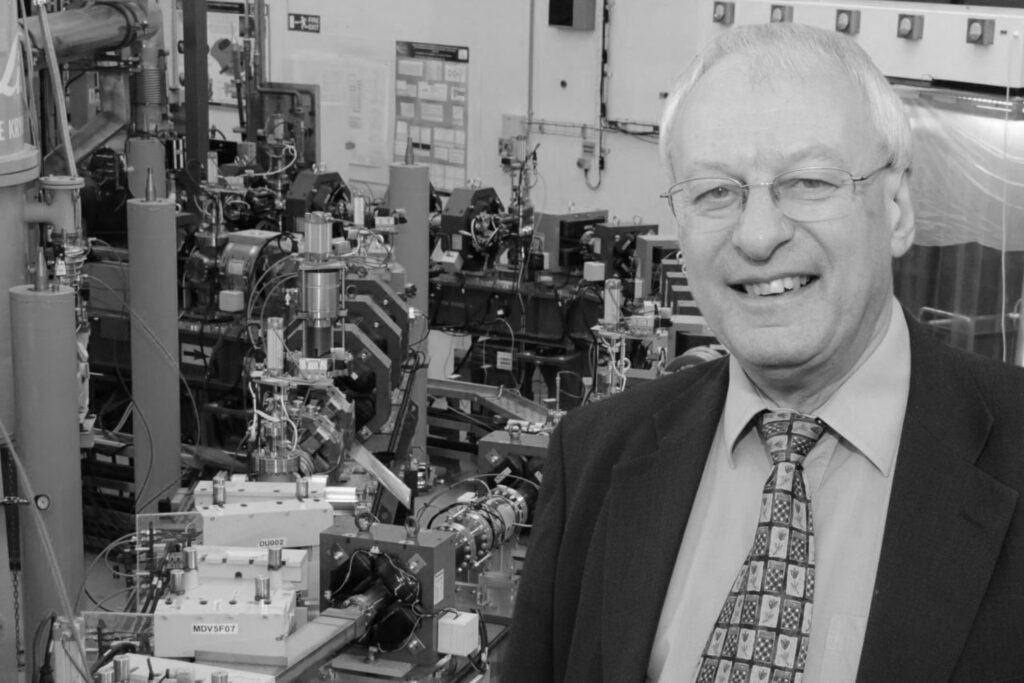Members of ASTeC, The Cockcroft Institute, STFC and the wider particle accelerator community will be saddened to learn of the death of Mike Poole, who passed away on 6th December 2023, aged 78.

Mike joined Daresbury Nuclear Physics Laboratory (as it was then known) in 1966 after graduating from the University of Liverpool with a degree in physics. He joined the Beam Physics Section where he helped design and operate the beam transport systems of the 5 GeV NINA electron synchrotron. Mike went on to spend the whole of his 44 year career working on various particle accelerator facilities at Daresbury.
Following his early work on NINA, Mike spent the majority of his career on accelerator-based light sources, reflecting the change in focus of Daresbury Laboratory itself. He successfully designed and measured all of the major magnet systems for the SRS, played a significant role in the design of the ESRF in Grenoble, and was a principal member of the team which successfully delivered the HELIOS compact light source in collaboration with Oxford Instruments. As leader of the Accelerator Physics Group during the 1990s, Mike led the beam physics design of the replacement for the SRS which, after a series of uninspiring acronyms, was to become known as the Diamond Light Source and which continues to be an outstanding facility for the UK research community today.
Mike always had an eye for what could be the next innovation and it was this interest that led to his lifelong passion for free electron lasers (FELs). He quickly recognised the potential of this new type of light source when it was demonstrated for the first time in the mid-1970s. He became an advocate for FELs of all types, personally initiating a project to build a similar demonstrator in the UK in 1978. This collaborative project, based at East Kilbride in Scotland, achieved gain but not lasing much to Mike’s disappointment. Nevertheless, the undulators for this project, built by Mike, were subsequently given to the Netherlands where they operated successfully for many years as part of the FELIX user facility. In fact it took until 2010, the year Mike retired, for the UK to finally achieve lasing in an FEL for the first time and fittingly it was at Daresbury on the ALICE energy recovery linac under Mike’s guidance!
In 2003, Mike assumed the position of Director of ASTeC. This was a crucial period in the department’s early history as it emerged from the shadow of the SRS and started to work on a much broader remit than just light sources. The delivery of Diamond Light Source was a major activity for ASTeC at that time but new work themes in linear colliders, neutrino factories, energy recovery linacs, FELs, and fixed field accelerators quickly developed and set the foundation for the successful department that we have today.
Another of Mike’s passions was raising the professional standing of accelerator science and technology in the UK. He often lamented the lack of an accelerator research activity in the UK universities and compared the UK against other countries which had both national laboratories and university groups active in the field. He was therefore very keen, when the opportunity arose in the early 2000s, to help establish the Cockcroft Institute, with ASTeC as one of the partners, and so helped to re-invigorate a vibrant research community within UK universities as well as the national laboratories. Later he spearheaded the establishment of the Particle Accelerator and Beams Group within the Institute of Physics, now one of the largest special interest groups of the Institute. Fittingly, he was awarded the Group’s prize for outstanding professional contributions in 2016.
Playing and watching sport was also a large part of Mike’s life. He played cricket and table tennis for many years and later moved onto bowls. In addition, he loved to talk about the latest sporting news, always rising to the bait where comments concerning Everton were concerned. In fact, Mike loved any sort of debate, he was very articulate and relished any opportunity to argue over the news of the day. He was well known for always having newspaper clippings in his jacket pocket which he would pull out with a flourish to get the debate going. Another of Mike’s quirk’s was his diet which seemed to revolve around meat and potatoes. He didn’t just not like fruit, he actively detested it and he seemed to have a special dislike of oranges which staff were banned from eating anywhere near his office since he claimed the smell make him ill! The irony that Mike served on the Daresbury Catering Committee for most of his career was not lost on anyone, including Mike who proudly boasted that chips were on the menu every day because of his influence.
Mike was a popular and inspiring leader and mentor to many. He always found the time to discuss any issues or offer advice where requested. He continued to be active beyond his retirement and fittingly his last paper, which was published in 2023, co-authored with Elaine Seddon, was a historical overview of FEL activities in the UK.
Mike leaves a wife, Rosemary, four children, Lisa, Nicola, Rebecca, and Andrew, and seven grandchildren. The sympathies of STFC and the Cockcroft Institute go to all members of the family.
